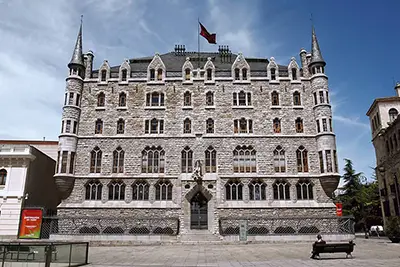 Buy Art Prints Now
Buy Art Prints Nowfrom Amazon
* As an Amazon Associate, and partner with Google Adsense and Ezoic, I earn from qualifying purchases.
Casa Botines was constructed in the North West Spanish city of Leon, making it one of Gaudi's few architectural projects outside of his native Catalonia.
Introduction
Gaudi travelled to the city of Leon to append his career with an exciting project which took in influences from gothic and medieval design. After serving a commercial purpose initially, the building would last the test of time and today serves as a museum to the artist himself.
Building Description
Casa Botines has been used for a variety of purposes since its original construction in the late 19th century. Currently it hosts a museum dedicated to the artist's life and career, but has previously been used for commercial purposes in the fashion and banking industries. The design created by Gaudi is loosely termed Modernist, which applies to much of Gaudi's work.
Whilst being classed as a Modernist building, Gaudi called upon the historical influences of the local area, taking elements of gothic and medieval design as inspiration for features within the building, and around its exterior. Local sculptors were hired to add statues around the exterior, but whilst the final construction was aesthetically impressive, it also served a clear function.
Commission
Eusebi Güell was a friend of Gaudi and asked him to construct a building in the city of Leon. A fabric company required somewhere with residential and commercial capacity, and agreed to commission Gaudi to make something suitable for their needs. Gaudi would not normally work in this region, but agreed to the project because of his relationships with those involved, and also the opportunity to produce something quite different to the rest of his architectural projects.
Gaudi's Role in Designing Casa Botines
The work was completed over two years, from 1891-1892. The project was given to this architect because of his existing connections to several individuals involved in the commissioned piece. It was Güell who introduced him to the businessmen seeking to construct this building. They were involved in the textile industry and also had links to the Catalan region.
A number of architectural elements make this work unique within Gaudi's career. He worked on providing more open space and also amended his usual approach around the foundations of the building, after concerns were raised by a number of local stakeholders. Many elements to this design were more functional, pragmatic, and consequently the building has lasted the test of time with few issues.
Conclusion
Casa Botines was a unique and exciting work within Gaudi's career, underlining his adaptability and consideration of the local environment for each of his projects. The building remains in place today and has remained structurally sound, thanks to his work in the late 19th century. It also helps to spread his reputation further, reminding others of the importance of his career, with the museum helping to strengthen this in Leon.
The influences from medieval architecture, whilst combined with his forward-thinking instincts, provides an interesting fusion of technique and design, and the project also illustrates the importance of his personal relationships on which projects he would choose to take on across his career.




